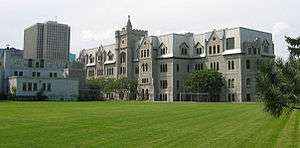Collegiate institute
A collegiate institute is a school either of secondary education or higher education. The definition varies regionally, and has been largely unused outside of Canada since the early 20th century.
Canada

In Canada, collegiate institute has a specific meaning. In 1871, the province of Ontario set up two parallel secondary education systems.[1] At this time Galt Collegiate Institute was the first, and one of only six schools in Ontario to have the name and privileges of being called a Collegiate Institute.[2] Collegiate institutes offered arts and humanities education, including Greek and Latin, for university-bound students. High schools offered vocational and science programs for those planning to enter the workforce upon graduation. This system was later adopted by other provinces including Manitoba, Alberta, and Saskatchewan.
It was quite quickly realized that this division did not work very well. Over time, high schools responded to students' needs and increasingly offered the arts courses that were essential for the workforce. At the same time, as universities began teaching science and engineering, so did the collegiate institutes. Within a decade, the distinctions between the two systems were greatly blurred, and eventually the two systems were merged in to a single secondary school system. Most new Ontario schools were from then on named either high schools or secondary schools, but the term "collegiate institute" is still used for new schools from time to time. In most cities, the oldest and most established high schools are still known as collegiate institutes. Most cities in Ontario have a collegiate institute near the centre. In some cases, a more academic focus has been retained, and collegiate institutes are thus sometimes regarded as better than "standard" high schools.
Many of Ontario's most prominent high schools are collegiate institutes, such as Toronto's Marc Garneau Collegiate Institute, Lisgar Collegiate Institute and Glebe Collegiate Institute in Ottawa, as well as Monarch Park Collegiate, Jarvis Collegiate Institute, William Lyon Mackenzie Collegiate Institute, Riverdale Collegiate Institute, North Toronto Collegiate Institute, York Mills Collegiate Institute, Danforth Collegiate and Technical Institute, Malvern Collegiate Institute, Richview Collegiate Institute, Humberside Collegiate Institute and Etobicoke Collegiate Institute in Toronto. In the case of Marc Garneau Collegiate Institute, Maclean's magazine ranked it as the top secondary school in Canada due to its TOPS Program. Almost every high school in the city of Toronto is a "collegiate institute". Contrasting the city, secondary schools in suburban Greater Toronto use a variety of titles. For example, within the neighbouring York Region District School Board, there exists secondary schools, like Bayview Secondary School, high schools, like Milliken Mills High School, and collegiate institutes, like Westmount Collegiate Institute.
In western Canada, far fewer schools are known as collegiate institutes, most having been closed or renamed in the decades since the separate systems were abolished. In Saskatoon and Regina, however, the term collegiate is still used to mean high school; all public high schools and some Catholic high schools there are "Collegiates," including those recently built or recently opened. Outside of Saskatoon, some remain such as Lethbridge Collegiate Institute in Lethbridge, Alberta, and Mennonite Brethren Collegiate Institute in Winnipeg, Manitoba.
United States

In the United States, the term has largely fallen into disuse. Collegiate institutes in the United States were, for the most part, colleges, and even the first name of Yale University when founded in 1701 was a similar-sounding Collegiate School. But the definition of a college in the U.S. also differs from that of other countries, and has been primarily based on the liberal arts college model of higher education. Two examples of collegiate institutes in the United States before the term fell out of use are the Oberlin Collegiate Institute of Ohio, now Oberlin College,[3] and the Pentecostal Collegiate Institute of New York and Rhode Island, now the Eastern Nazarene College of Massachusetts.[4] Both were founded as postsecondary institutions (in 1833 and 1900, respectively), but the latter would drop its college curriculum and exist as a college preparatory school from 1902 until 1918, demonstrating the flexibility of the term collegiate institute. Partly because the term institute holds some ambiguity, many such schools would later change their names to use college instead of collegiate institute to more accurately represent their nature and mission, and the term "collegiate institute" would see little use beyond the early 20th century.
Notes and references
- ↑ The Cyclopædia of education by Henry Kiddle, Alexander Jacob Schem. Published by E. Steiger, 1876. p. 668.
- ↑
- ↑ Oberlin College Archives: Historical bibliography
- ↑ Cameron, James R. (1968). Eastern Nazarene College—The First Fifty Years, 1900-1950. Kansas City: Nazarene Publishing House.